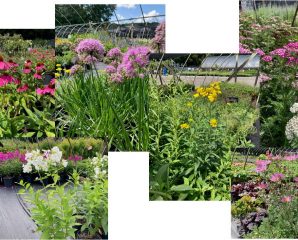Cut flowers continue to grow in popularity, as consumers look for locally grown fresh flowers. Early fall is a great time to start a cut flower bed, and get bulbs and perennials in the ground for an early start in the spring. Tulips (most popular cut flower!), daffodils and alliums are all popular bulb varieties, along with a number of perennials. The list below includes a number of species that will rebloom after a harvest.
Preparation – plan ahead to maximize your flower harvest
Site selection
- Six hours of sun per day – a section of a vegetable garden can be the perfect location.
- Irrigation or within reach of a hose
- Protected from gusty winds
Bed preparation
- Narrow, rectangular spaces are easy to tend and harvest. Beds that are four feet wide or less can be easily be reached from either side.
- Raised beds are easier to tend, and allow for soil amendment.
- Rich, well drained soil. Prep the soil by adding organic matter (compost, worm castings, etc) before planting to increase nutrients, aeration and water holding capacity. If creating a raised bed, add good quality potting soil. A dose of a balanced organic fertilizer (such as Plant-Tone) at the beginning of the season will keep plants healthy and growing throughout the season.
- Mulch with shredded leaves or straw. It helps to prevent weeds, retains moisture and protects new seedlings. Top off with fresh mulch when there is less than one inch left.
Planting plan
- Locate annuals and perennials in different areas. Annuals may need to be replaced once blooms are spent, same with bulbs.
- Group plants with similar needs together. Consider water requirements so plants aren’t over- or under-watered. Be aware that some plants (coreopsis!) will perform better with lean soil.
- Keep in mind bloom times, and have something new flowering at all times.
- Make sure shorter plants are in front of the taller ones so they receive sufficient sunlight.
- Ornamental grasses make great filler for bouquets.
Consider these varieties , listed in order of bloom time:
- Lenten Rose, Hellebores, March – May
- Daffodil, Narcissus, March-May
- Asiatic Lily, Lilium asiatica, April-June
- Rose, Rosa, April – October
- Tulip, Tulipa, April – May
- Ornamental Onion, Allium, May – July
- Iris, Iris Germanica, May – June
- Shasta Daisy, Leucanthemum superbum, May – October
- Peony, Paeonia, May to June
- Verbena, Verbena bonariensis, May – October
- Black-eyed Susan, Rudbeckia, June – October
- Phlox, Phlox paniculata, June – October
- Salvia, Salvia, June – October
- Pincushion Flower, Scabiosa, June – October
- Bellflower, Campanula, June – September
- Coneflower, Echinacea, June – September
- Coral Bells, Heuchera, June – September
- Tickseed, Coreopsis, June – September
- Yarrow, Achillea, June – September
- Windflower, Anemone, July – October
- Blazing Star, Liatris spicata, July – September
- Balloon Flower, Platycodon, July – September
- Aster, Symphotrichum and Aster, August – October
- Mum, Chrysanthemum, August – October
- Sneezeweed, Helenium, August – October

